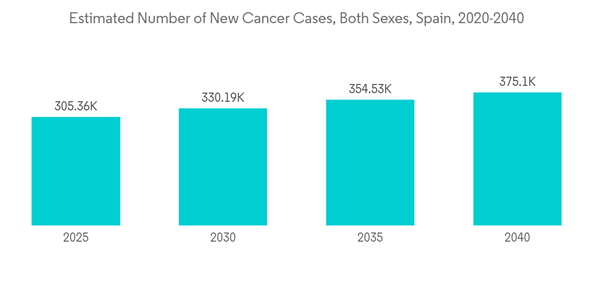COVID-19 had an adverse impact on the magnetic resonance imaging market in Spain. Various research studies have been published to provide insight into the effects of the pandemic on the studied market. According to the research study published in June 2021, titled 'Significant Decrease in Annual Cancer Diagnoses in Spain during the COVID-19 Pandemic: A Real-Data Study', the highest number of patients lost from diagnosis in 2020 was in breast cancer (-26.1%), colorectal neoplasms (-16.9%), and head and neck tumors (-19.8%) which shows a negative impact of the COVID-19 on the studied market in the country. However, according to early data from cardiac magnetic resonance imaging (MRI), residual myocardial inflammation may be seen at rates as high as 60% at a COVID-testing facility more than 2 months following a COVID-19 diagnosis. In Spain, 28 centers participated in a multicenter registry, according to an article titled "A Multicenter Registry." Acute cardiovascular disease has been identified in patients who have been diagnosed with COVID19. 82 patients in all took part in the trial. Nine of them (14.1%) had acute myocarditis, while the others either had stress cardiomyopathy or acute myocardial infarction. 83.3% of myocarditis patients had heart failure, with 25% of them mimicking an acute coronary syndrome. Cardiac MRI helped to identify these problems. As a result, there will likely be a demand for MRI technology to diagnose Covid problems in the future.
The major factors that are expected to drive the growth of the studied market of magnetic resonance imaging (MRI) in Spain are the increasing burden of chronic diseases and initiatives by market players. The incidence of acquired brain damage in children is 191/100,000, with an even higher prevalence, according to data from the Federation of Brain Injury in Spain (FEDACE) 2020. In addition, there are 120,000 cases of congenital brain injury known as cerebral palsy in Spain. According to GlOBOCAN Spain 2020, there are 4,420 new cases of brain and central nervous system malignancies, and 3, 283 people have died as a result of these illnesses. Several market participants are engaged in strategic projects that are promoting market expansion. For instance, in January 2021, a 5-year innovation and partnership deal was struck by Royal Philips and Vithas group, the second-largest private healthcare organization in Spain. In accordance with the agreement, four new hybrid operating rooms with ceiling-mounted live-image guidance systems will be installed in addition to replacing current Vithas Group MR equipment. Additionally, Philips will oversee CT systems, x-ray machinery, and dose management programs. Therefore, it is anticipated that advances related to open magnetic resonance imaging (MRI) systems will increase market growth in this sector.
However, it is anticipated that the market expansion in Spain will be constrained by inadequate reimbursement and the high cost of equipment.
Spain Magnetic Resonance Imaging Market Trends
Closed MRI Systems Segment is Expected to Hold a Significant Market Share Over the Forecast Period
Anatomical structures in the wrist, hepatic metastases, fibrocartilage lesions, patients with brachial plexus lesions will be able to see their nerves, lesions in multiple sclerosis, and multi-vessel or single diseases in patients with coronary artery disease are all best diagnosed using a closed magnetic resonance imaging (MRI) system (CAD). Closed MRI systems are favored over open MRI systems because they can diagnose more issues than open MRIs can. Magnetic field strengths are measured in Tesla, or "T," and are typically between 0.5T and 3.0T. The major factors that are expected to drive the growth of the studied market of magnetic resonance imaging (MRI) in Spain are the increasing burden of chronic diseases and initiatives by market players. For instance, the Globocan 2020 report states that Spain reported 282,421 instances of cancer in 2020, with colorectal cancer being the most common type and accounting for roughly 14.3% of all cancer cases in the nation. Additionally, according to the same report, there were 858,220 cancer cases overall in the previous five years, with projections that the number will rise to 330,189 by 2030 and 375,098 by 2040. Thus, if cancer cases rise in the nation, more magnetic resonance imaging systems are likely to be used for cancer diagnoses and tumour monitoring, which will propel the growth of the country's researched market.Initiatives in the country are expected to increase market growth. For instance, project GAMMA MRI was launched in April 2021 by the Haute École Spécialisée de Suisse Occidentale (Switzerland), the European Organization for Nuclear Research (CERN; Switzerland), the University of Geneva (Switzerland), the Universidad Complutense de Madrid (Spain), KU Leuven (Belgium), and the businesses Tecnologas Avanzadas Inspiralia (Spain) and RS2D (France By creating a point-of-care molecular imaging device based on a ground-breaking imaging principle that enables the simultaneous exploitation of the sensitivity of gamma () detection and the spatial resolution and flexibility of MRI, the GAMMA-MRI project advances current technological paradigms in brain imaging. Initiatives like this are also anticipated to accelerate the expansion of the targeted market in the nation. Therefore, due to the above-mentioned factors, the closed MRI systems segment in the magnetic resonance market in Spain.
Spain Magnetic Resonance Imaging Industry Overview
Spain magnetic resonance imaging market is moderately competitive and consists of several major players. Some of the companies that are currently dominating the market are GE Healthcare, Siemens Healthineers AG, Canon Medical Systems Corporation, Fujifilm Holdings Corporation, and Koninklijke Philips NV among others.Additional Benefits:
- The market estimate (ME) sheet in Excel format
- 3 months of analyst support
This product will be delivered within 2 business days.









